The murder of Nikos Tebonera in Patras exactly 30 years ago (January 8, 1991 was the fatal blow, as it turned out, on January 9 the professor expired) can clearly be categorized as a political murder, like those that took place several times -unfortunately- in post-modern Greece. In short, Teboneras had the "luck" of Lambrakis, Petroulas, Koumis, Kanellopoulou. All of them fell from state or parastatal hands but before 1989, when the National Reconciliation became a fact. In 1991 things were supposed to be different. And yet, it wasn't.
In order for the younger reader who, because of his age, did not live in this era to understand the facts accurately, some very useful and basic information is necessary. From the end of November 1990 the movement of student occupations started to flare up. The reason was an indulgently obscurantist bill, the Kontogiannopoulos bill, for the reform of education at all levels, which took educational Greece back four decades. There were, characteristically, provisions that tried to regulate the life of students outside of school (!) while according to others, even the raising of the flag was foreseen (a function common in the camps).
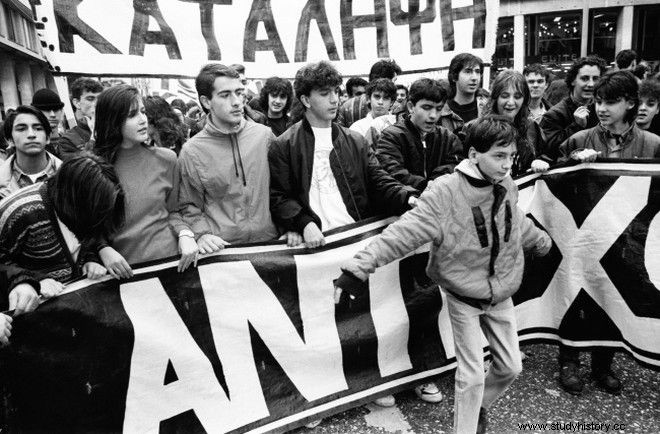
The Prime Minister of the country was Konstantinos Mitsotakis with a small majority of 151 MPs (later it reached 152) and the official opposition was the PASOK of Andreas Papandreou.
The policy of the Mitsotakis government at the time was decidedly neoliberal and conservative. Public enterprises were privatized, welfare state services suffered savage cuts, repression increased. But no one expected that in 1991, parastatal groups would be active in the streets of a big city, such as Patras. And that these groups would develop an action that would end in a brutal murder of an unarmed man in a schoolyard.
Seizures and repossessions
Valuable material about the circumstances under which Nikos Teboneras was murdered comes from the book that was released in 2020 and has the title "The Sixteenth of Our Life". It is a collection of speeches and texts delivered and written by Michalis Vassilakis, a fellow traveler in the political activity of Nikos Teboneras and which was edited by Vassilaki's (now deceased) partner, Ourania Birba. The cover of the book, published by KPSM publications, was designed by the murdered man's daughter, Eva Tebonera.
From the chronicle included in the book, but also from the press of the time, we learn that the Mitsotakis government was looking for ways to "break" the occupation movement (which in December turned into a tsunami of mobilization throughout Greece) so , so that schools can return to normal operation without being forced to back down politically. The pro-government press has already been giving the slogan since the holiday season, during which schools remained closed. The time had come for the "indignant citizens" who, however, in the case of Patras, were nothing more than members of the local ONNED acting as a parastatal strike group.
A certain "Free Press" article has gone down in history. It was published on January 8 and was titled "Forward on the path that Amaliada laid out". He was referring to incidents that had erupted the previous day in Amaliada in which "outraged citizens" occupied the city's town hall to protest the student sit-ins. The editor concludes in his short note:"You have even taken over the houses of the...Patched!" Balomenos was the name of the then president of OLME. And if that's not incitement to violence, then what is?
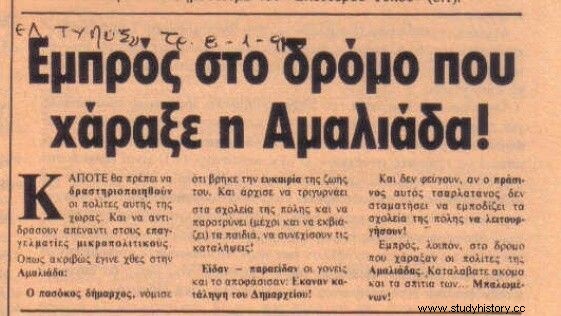
There had been specific preparation for Patras. The Achaean Deputy Minister of Education Vassilis Bekiris came down to Patras on December 22nd and participated in a broad meeting with party officials, including ONNED members. There, Yiannis Kalambokas, the man who managed the fatal blow to the head of Nikos Tebonera a few days later, had even protested because ONNED had not been used yet. The Deputy Minister hastened to reassure him. "It's not time yet. We'll be using you soon!"
The group headed by Yiannis Kalambokas started its activity from the local ELME building but also from the Polytechnic Schools of the city. Because of the guard, he didn't manage to do anything. But she didn't give up and armed with crowbars and other weapons of war, she headed to the school complex in VOUD square which was also under occupation like all the schools in the area. There, students attack the squatters with unprecedented speed and even shave the hands of the 15-member president, Kostas Skremydas (a firefighter by profession today). They show that they are determined to cause even bloodshed. The 18-year-old Skremydas is then photographed with the bandages on his hands.
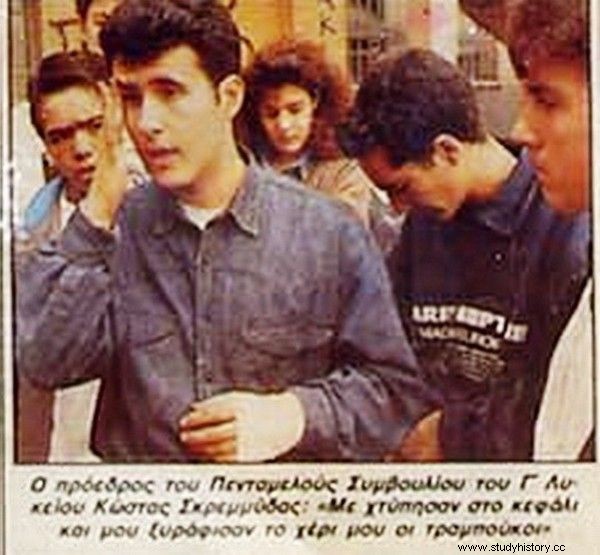
Nikos Teboneras, 38 years old, was at ELME Patras and was talking with his companions. There they received a phone call from student squatters that the squat had been "broken" by a group unknown to them, which used brute force. The then Mayor of Patras Andreas Karavolas was also informed about the development. Both a delegation of ELME (in which Teboneras participated) and the Mayor rushed to the school to prevent the worst. They knew that the group that had proceeded with the recapture was extremely dangerous and that their violent action had been recorded in Patras in previous years as well. Nevertheless, they went to the school on their own without notifying the authorities. They believed that the presence of the Mayor would deter the parastatals from violence. They laughed. At the same time the president of ELME Rena Antonelli communicates with the local media of Patras and warns PUBLICLY that blood will be spilled in the city if there is no firefighting intervention by the Police and the organized state in order to limit the parastatals.
Later it became known that the authorities, despite the fact that they had been notified by both students and parents, never showed up. At least not before the murder. Even so, Teboneras and his companions headed to the school without believing that there was going to be a murder. If they believed that, they would have taken different measures.
The attempt of Mayor Karavolas to convince the parastatals to leave has no counterpart. On the contrary, it probably infuriates them. So they leave the halls, approach the door, where Nikos Teboneras is and "knock". Then, shortly after 10 pm, the professor receives the fatal blow from the iron rod that Kalambokas was holding in his hands. Despite the fact that Teboneras collapses, in seconds comes another blow from the same perpetrator as the eyewitnesses confirm. From that moment on, Nikos Teboneras does not exist in life. His brain is almost pulverized where he was hit. Brain matter is rolling on the ground.
Here's what the coroner's report says:"Crushing skull fracture parasagittal left at the level of the auditory canals, size 4.5cm transversely x 4cm sagittally, shape of an irregular quadrilateral. Fatal head injury possibly caused by an iron and heavy instrument. The direction of the instrument was from the left parietal region to the right orbit. The instrument penetrated the scalp, the underlying skull, the dura mater and the underlying brain, reaching the right eye socket where it fractured the orbital roof and the horizontal lobe of the ethmoid. The brain injury caused profuse bleeding, brain swelling, and subsequent outflow and loss of brain matter from the left parietal wound and through the nose through the ethmoid sinuses. Death was a direct result and consequence of this injury".
The authorities are hiding the criminal group
As expected, panic sets in. Teboneras is taken to the hospital of Agios Andreas in the car of Mayor Andreas Karavolas in order not to waste time. The doctors find that the situation is extremely difficult. However, because the hospital does not have a CT scanner, they order an immediate transfer to the University of Rio de Janeiro. The transport and examination are indeed done and the doctors in Rio conclude that Teboneras is brain dead. He breathed his last at 7 am on January 9.

Before Teboneras even ends, the news of the murderous attack has made the rounds of Patras and the first marches begin to be organized. At the same time, the perpetrators disappear and hide, apparently to avoid the self-incrimination. Citizens, who were eyewitnesses to the attack, rush to the police stations to give a statement. And there, as the editor of the book on Nikos Tebonera, Urania Birba, informs us, the unheard of happens:The police did not even keep the details of those who gave statements, it was as if the statements were not given.
The crowbar, the instrument used in the murder, was never found! Nor, of course, did he appear in court. The police generally did not show any particular interest in identifying the perpetrators, although they knew their identity almost from the first moment.
Nikos Teboneras, an allegorical guy, very pleasant and fond of hobbies such as diving and snorkelling, succumbed. He left behind his wife Athena and his two children, Eva and Dionysis. His death shocked the pan-Hellenic community and caused a new tsunami of mobilizations and occupations, terrorizing the government, which hastened to change ministers (Vassilis Kontogiannopoulos was replaced by Giorgos Souflias) while the bill was withdrawn. The press of the time, at least the opposition, spoke of a parastatal. And he was right. Tebonera's murder was strongly reminiscent of that of Grigoris Lambrakis in Thessaloniki in 1963. And the murder was carried out in a recapture attempt by "indignant citizens" who seem to have been politically motivated.
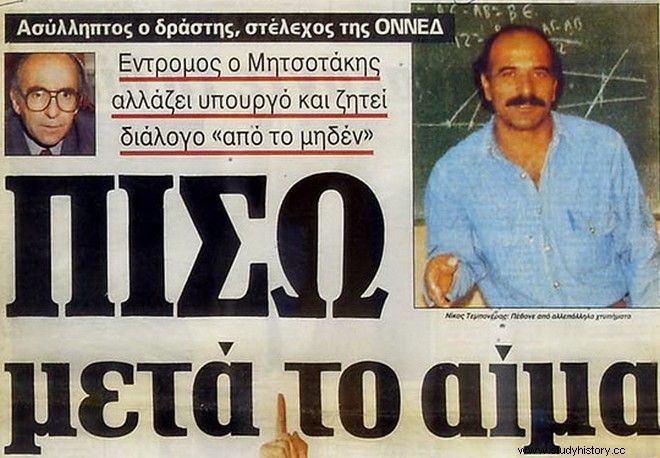
Teboneras believed in a democratic school and in general in a democratic society. He supported the student struggle with all his being, because he considered it just. He had come to the conclusion that the Kontogiannopoulos bill was bringing the Greek school back to the 50s. And he paid for this attitude with his life. Did his family at least find vindication in the many trials that followed over the case? This question raises a conversation.
Protection from above to "outraged" defendants
What happened from the moment Nikos Teboneras was murdered until the release of Yiannis Kalabokas, just seven years after the murder, does not honor the rule of law in Greece. Despite the enormous popular pressure expressed in various ways in those days, there seems to have been a mechanism working underground to ensure that Kalamboka and his co-accused received the best possible treatment. It should be noted that Kalambokas was also a municipal councilor in the Municipality of Patras with the combination of Nikos Nikolopoulos, then a New Democracy MP and later ANEL MP.
At the same time, in Athens, to which the theater of conflicts is transferred, a multiple state assassination takes place. A fire breaks out in the building of K. Marousis, on University Street, from the tear gas of the MAT during a street fight between the police and young people, which took place in the line of the march for the murder of Tebonera. Four people are burned alive! Anger is now reaching unprecedented levels and the situation is starting to resemble the turbulent 60s. The government, a year and a half after its election, is faltering, showing that it cannot control the situation.
The suspects for the murder appear six days after the bloody night and after their lawyer had taken responsibility for their...disappearance. The relevant investigation lasted 13 months, while a commission of inquiry into the event is being set up in the Parliament. A member of the committee is also Nikos Nikolopoulos with whose ballot Yiannis Kalambokas had won a seat on the municipal council of Patras.
In the following video there are historical documents of the days. From 24.:18 the statement of the defense counsel of the defendants.
The first trial is set in... Volos. But despite the long distance, outside the court building there are no shortage of protesters demanding justice for Nikos Tebonera. The president of the court is an honest and excellent judge, the current president of the National Radio and Television Council, Athanasios Koutromanos.
The defense of Kalaboka is undertaken by prominent names of the New Democracy. Kostas Konstantinidis (an accuser a few years earlier in the Koskotas scandal trial), Apostolos Andreoulakos and Epaminondas Zafeiropoulos are among them.

On the other hand, the head of the civil action is the iconic figure of Giorgos Alexandros Magkakis, former Minister of Justice and distinguished jurist. The decision of the Mixed Jury Court of Volos leaves no room for misinterpretation:Life without any mitigation for Yiannis Kalabokas.
However, the methods do not stop. After the first appeal court in Larissa, which was held in record time, the sentence drops to 17.5 years. In 1996 now, and while PASOK has been in power since 1993, the effort to make Kalambokas go soft continues. After an appeal by the Supreme Court, the case returns to the Larissa Court of Appeal and the sentence is reduced again (16 years and 9 months).
Public opinion is no longer particularly concerned with the event, as almost six years have passed since the murder. But the family and friends of Nikos Tebonera cannot forget. The wife of the murdered man, Athina Tebonera, bursts out and declares:"Unfortunately, 6 years later, I feel, we feel, the iron heel of protection treading menacingly on the grave of the late Nikos Tebonera. Out of little respect for the memory of Nikos Tebonera, my children, in thousands of the world but also to the judges who stood up honoring their role and their conscience. I do not PRETEND myself as a political plaintiff, nor do I appoint advocates for civil litigation. Let everyone take their responsibilities".
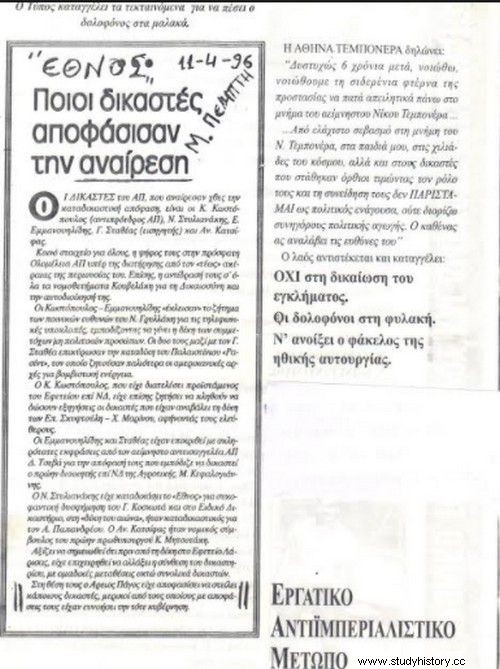
In the end, no one took responsibility. On the plea of "sincere remorse", Kalambokas was released in 1998 having served 2/5 of his sentence. Since then he has lived in Volos where he had a career as a bank clerk (bank clerk was his profession anyway). Nikos Teboneras simply gave his name to the school where he was murdered and to a tunnel of Olympia Road located near Patras.
His memory will be honored by his comrades in the Labor Anti-Perialist Front (on Saturday, January 9) but also by those who are always inspired by the blood shed by popular activists. Such was Nikos Teboneras who would have been 68 years old today.
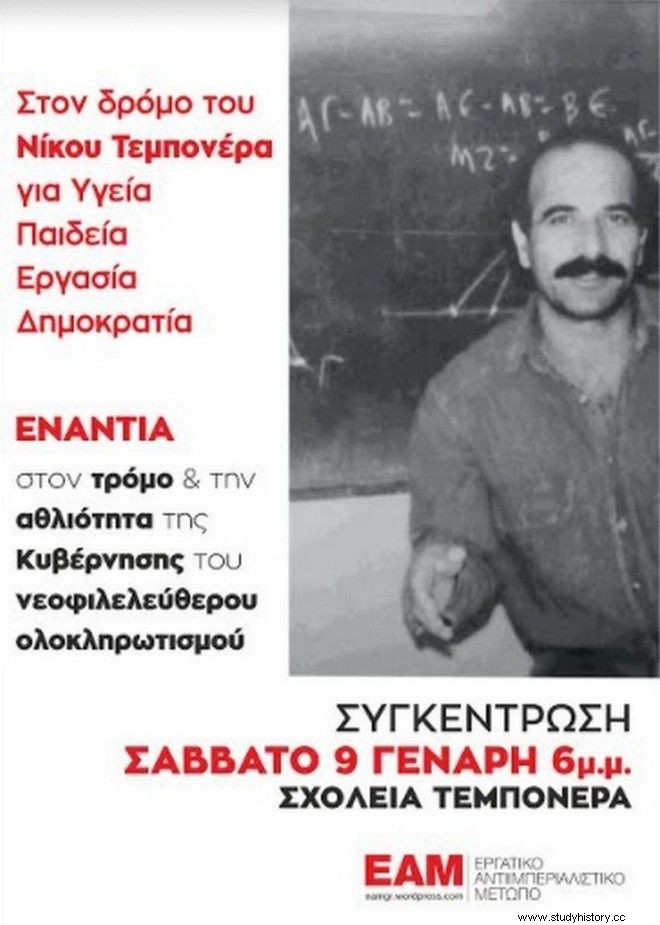
Read the News from Greece and the world, with the reliability and validity of News247.gr
